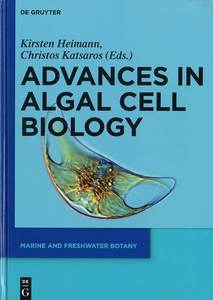Algal cell biology: important tools to understand metal and herbicide toxicity
Heimann, Kirsten (2013) Algal cell biology: important tools to understand metal and herbicide toxicity. In: Heimann, Kirsten, and Katsaros, Christos, (eds.) Advances in Algal Cell Biology. Marine and Freshwater Botany . Walter de Gruyter, Berlin, Germany, pp. 191-210.
![[img]](https://researchonline.jcu.edu.au/25705/3.hassmallThumbnailVersion/25705_Heimann_2013_Cover.jpg)
|
Image (JPEG) (Book Cover)
- Cover Image
Download (171kB) |
|
|
PDF (Published Version)
- Published Version
Restricted to Repository staff only |
Abstract
[Extract] Light emission is an easily quantifiable parameter which enables quantification of effects of photosystem II inhibiting herbicides using PAM (pulse amplitude modulated) fluorometry e.g. (Magnusson et al. 2008) or metal and other pollutants (including herbicides) effects on the bioluminescent response system of marine dinoflagellates and bacteria (Vibrio spp) (Craig et al. 2003; Heimann et al. 2002; Okamoto et al. 1999; Parvez et al. 2006). Therefore, and because the assays fulfill the criteria of toxicity tests, such as ease of handling, rapid and reliable data acquisition and cost saving, both methodologies are being used increasingly in environmental monitoring and in ecotoxicology as toxicity tests (Heimann et al. 2002; Parvez et al. 2006). Toxicity of photosynthesis inhibiting pollutants is recorded as an increase in chlorophyll fluorescence and a decrease in effective quantum yield when using PAM fluorometry (Magnusson et al. 2008), while pollutants that inhibit the bioluminescent reaction are recorded as a decrease in luminescent light output (Craig et al. 2003; Heimann et al. 2002). This chapter will not report on or summarise ecotoxicolgical experiments using either PAM or bioluminescence, rather the intent is to elucidate how knowledge of bioluminescent pathways and the regulation thereof can be used to make inferences of the mechanism of action of pollutants. For this purpose the bioluminescent system of the marine dinoflagellate Pyrocystis lunula will be used as a model and its bioluminescent system as well as its regulation is briefly described below.
| Item ID: | 25705 |
|---|---|
| Item Type: | Book Chapter (Research - B1) |
| ISBN: | 978-3-11-022960-8 |
| Funders: | James Cook University (JCU) |
| Date Deposited: | 17 Jun 2013 06:20 |
| FoR Codes: | 06 BIOLOGICAL SCIENCES > 0601 Biochemistry and Cell Biology > 060111 Signal Transduction @ 50% 06 BIOLOGICAL SCIENCES > 0601 Biochemistry and Cell Biology > 060110 Receptors and Membrane Biology @ 50% |
| SEO Codes: | 83 ANIMAL PRODUCTION AND ANIMAL PRIMARY PRODUCTS > 8301 Fisheries - Aquaculture > 830199 Fisheries - Aquaculture not elsewhere classified @ 100% |
| Downloads: |
Total: 895 Last 12 Months: 21 |
| More Statistics |



